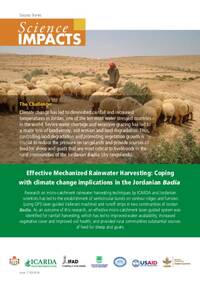Effective Mechanized Rainwater Harvesting: Coping with climate change implications in the Jordanian Badia
Published Date
February 29, 2016
Type
Brief

Authors:
Research on micro-catchment rainwater harvesting techniques by ICARDA and Jordanian
scientists has led to the establishment of semicircular bunds on contour ridges and furrows
(using GPS laser-guided Vallerani machine) and runoff strips in two communities of Jordan
Badia. As an outcome of this research, an effective micro-catchment laser-guided system was
identified for rainfall harvesting, which has led to improved water availability, increased
vegetative cover and improved soil health, and provided rural communities substantial sources
of feed for sheep and goats.
Citation:
Theib Oweis. (29/2/2016). Effective Mechanized Rainwater Harvesting: Coping with climate change implications in the Jordanian Badia. Amman, Jordan: International Center for Agricultural Research in the Dry Areas (ICARDA).
Keywords:
livelihoods improvement
loss of biodiversity
feasibility
mechanized rainwater harvesting technique
rate of return
atriplex halmus
vallerani
vallerani contour bunds
contour laser guiding (clg) system
excavation
vallerani machine
plow
hydraulic arm
integrated watershed management approach
land suitability analysis
bunds
intermittent pit excavation
furrows
micro-catchment water harvesting techniques
runoff strips
herders
contour ridges
impact study
land degradation
rangelands
rural communities
sheep
goats
feeds
soil erosion
mechanization
livestock feed
scientific research
semiarid climate
rainwater harvesting
